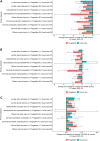Effectiveness of Pregabalin Treatment for Neuropathic Pain in Patients with Spine Diseases: A Pooled Analysis of Two Multicenter Observational Studies in Japan
- PMID: 33758538
- PMCID: PMC7981152
- DOI: 10.2147/JPR.S293556
Effectiveness of Pregabalin Treatment for Neuropathic Pain in Patients with Spine Diseases: A Pooled Analysis of Two Multicenter Observational Studies in Japan
Abstract
Purpose: Neuropathic pain (NeP) is common among patients with chronic pain associated with spine diseases. Practical effectiveness of pregabalin, one of the first-line treatments for NeP, has not been evaluated in an entire population of patients with spine diseases, including various pathophysiological conditions. This pooled analysis aimed to evaluate the therapeutic value of pregabalin for chronic pain with NeP component in patients with spine diseases in routine primary care settings.
Patients and methods: We pooled data from two 8-week prospective observational cohort studies for patients with chronic low back pain with accompanying lower limb pain (NeP component), and patients with chronic cervical pain and accompanying upper limb radiating pain (NeP component) in routine primary care settings in Japan. For both studies, patients were treated for 8 weeks with pregabalin (alone/with other analgesics) or usual care with conventional analgesics (eg, non-steroidal anti-inflammatory drugs). Changes in pain numerical rating scale (NRS), Pain-Related Sleep Interference Scale (PRSIS), and EuroQol 5-dimension 5-level (EQ-5D-5L) scores from baseline to week 8 were summarized and compared between the pregabalin and usual care groups, and also for subgroups of primary diagnosis. Safety was evaluated by adverse events (AEs) in the pregabalin group.
Results: The pooled dataset comprised 700 patients (pregabalin group: 302; usual care group: 398). All patient-reported outcomes (PRO) scores significantly improved from baseline to week 8 in the pregabalin than in the usual care group (NRS: P<0.0001; PRSIS: P<0.0001, and EQ-5D-5L: P=0.0006). Overall, all three PRO measures showed greater improvement in the pregabalin than in the usual care group, irrespective of the primary diagnosis. AEs were reported in 36.1% of the pregabalin group.
Conclusion: This analysis suggested multi-faceted effectiveness of treatment with pregabalin from the patient's perspectives under a "real-world" practice in all patients with chronic NeP from various spine diseases.
Keywords: chronic pain; neuropathic pain; pooled analysis; pregabalin; spine diseases.
© 2021 Taguchi et al.
Conflict of interest statement
Shogo Nakano and Kazutaka Nozawa were employees of Pfizer Japan, Inc. at the time of study conduct and manuscript development. Toshihiko Taguchi was not financially compensated for their collaboration in this project or for the development of this manuscript, although Toshihiko Taguchi has received honorarium from Pfizer Japan Inc. outside of this work. The authors report no other conflicts of interest relevant to this work.
Figures



Similar articles
-
Effectiveness of pregabalin for the treatment of chronic low back pain with accompanying lower limb pain (neuropathic component): a non-interventional study in Japan.J Pain Res. 2015 Aug 5;8:487-97. doi: 10.2147/JPR.S88642. eCollection 2015. J Pain Res. 2015. PMID: 26346468 Free PMC article.
-
Effectiveness of pregabalin for treatment of chronic cervical radiculopathy with upper limb radiating pain: an 8-week, multicenter prospective observational study in Japanese primary care settings.J Pain Res. 2019 May 3;12:1411-1424. doi: 10.2147/JPR.S191906. eCollection 2019. J Pain Res. 2019. PMID: 31118759 Free PMC article.
-
Direct and Indirect Pathways for Health-Related Quality of Life Change from Pain Improvement in Neuropathic Pain Patients with Spine Diseases: Path Analysis with Structural Equation Modeling Using Non-Interventional Study Results of Pregabalin.J Pain Res. 2021 Jun 1;14:1543-1551. doi: 10.2147/JPR.S289396. eCollection 2021. J Pain Res. 2021. PMID: 34103979 Free PMC article.
-
Pregabalin for the treatment of neuropathic pain: a narrative review for primary care providers.Curr Med Res Opin. 2017 Aug;33(8):1353-1359. doi: 10.1080/03007995.2017.1322051. Epub 2017 Jun 9. Curr Med Res Opin. 2017. PMID: 28426255 Review.
-
Pregabalin for the Treatment of Neuropathic Pain: A Systematic Review of Patient-Reported Outcomes.Cureus. 2024 Sep 29;16(9):e70443. doi: 10.7759/cureus.70443. eCollection 2024 Sep. Cureus. 2024. PMID: 39473674 Free PMC article. Review.
Cited by
-
Community Pharmacists' Perceptions towards the Misuse and Abuse of Pregabalin: A Cross-Sectional Study from Aseer Region, Saudi Arabia.Healthcare (Basel). 2021 Sep 28;9(10):1281. doi: 10.3390/healthcare9101281. Healthcare (Basel). 2021. PMID: 34682961 Free PMC article.
-
Efficacy and Safety of Add-on Mirogabalin to NSAIDs in Lumbar Spinal Stenosis with Peripheral Neuropathic Pain: A Randomized, Open-Label Study.Pain Ther. 2022 Dec;11(4):1195-1214. doi: 10.1007/s40122-022-00410-z. Epub 2022 Jul 20. Pain Ther. 2022. PMID: 35857196 Free PMC article.
-
Nociceptive pain assessed by the PainDETECT questionnaire may predict response to opioid treatment for chronic low back pain.Heliyon. 2024 Feb 6;10(3):e25834. doi: 10.1016/j.heliyon.2024.e25834. eCollection 2024 Feb 15. Heliyon. 2024. PMID: 38356562 Free PMC article.
-
What Is New in the Clinical Management of Low Back Pain: A Narrative Review.Cureus. 2022 Mar 9;14(3):e22992. doi: 10.7759/cureus.22992. eCollection 2022 Mar. Cureus. 2022. PMID: 35464575 Free PMC article. Review.
-
Efficacy and Safety of Mirogabalin in Patients with Neuropathic Pain Due to Cervical Spondylotic Radiculopathy: Miro-Cens, A Randomized, Controlled, Interventional Study.Pain Ther. 2025 Jun;14(3):1063-1079. doi: 10.1007/s40122-025-00722-w. Epub 2025 Apr 12. Pain Ther. 2025. PMID: 40216732 Free PMC article.
References
-
- International Association for the Study of Pain [homepage on the Internet]. Washington, D.C.: IASP Terminology; 2017. Available from: https://www.iasp-pain.org/terminology?navItemNumber=576#Neuropathicpain. Accessed May26, 2020.
-
- Ogawa S, Komatsu M, Ohno S, Yamane H, Hayakawa K. Pregabalin (Lyrica) Shiyou seiseki chousa: chukan kaiseki houkokusho [Interim report of drug use investigations of pregabalin (Lyrica)]. Prog Med. 2013;33(10):2159–2171.
LinkOut - more resources
Full Text Sources
Other Literature Sources
Medical

